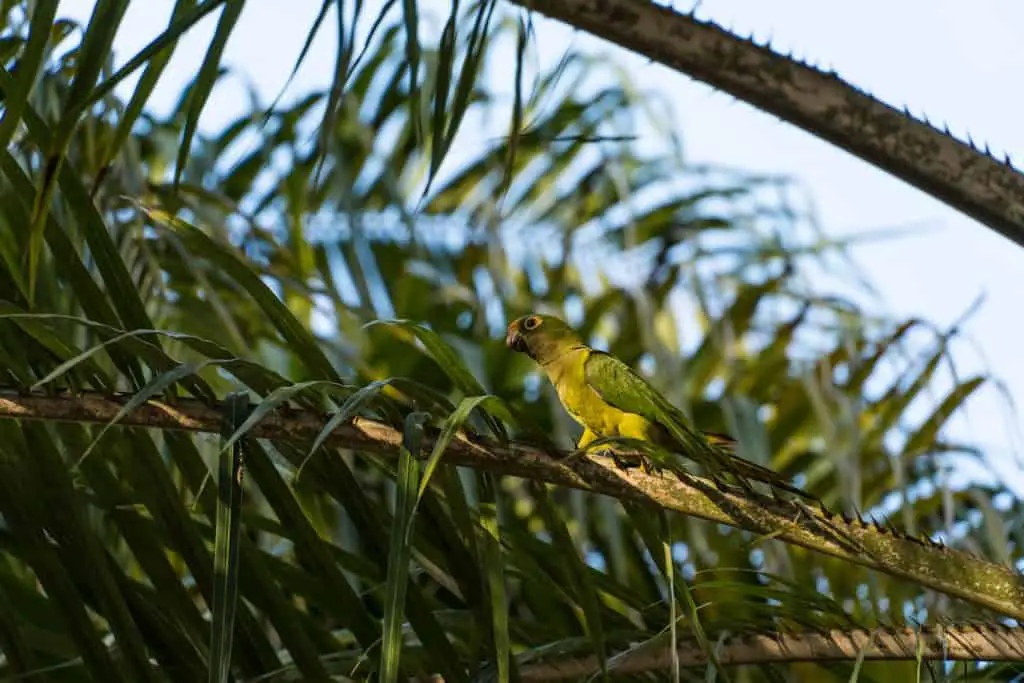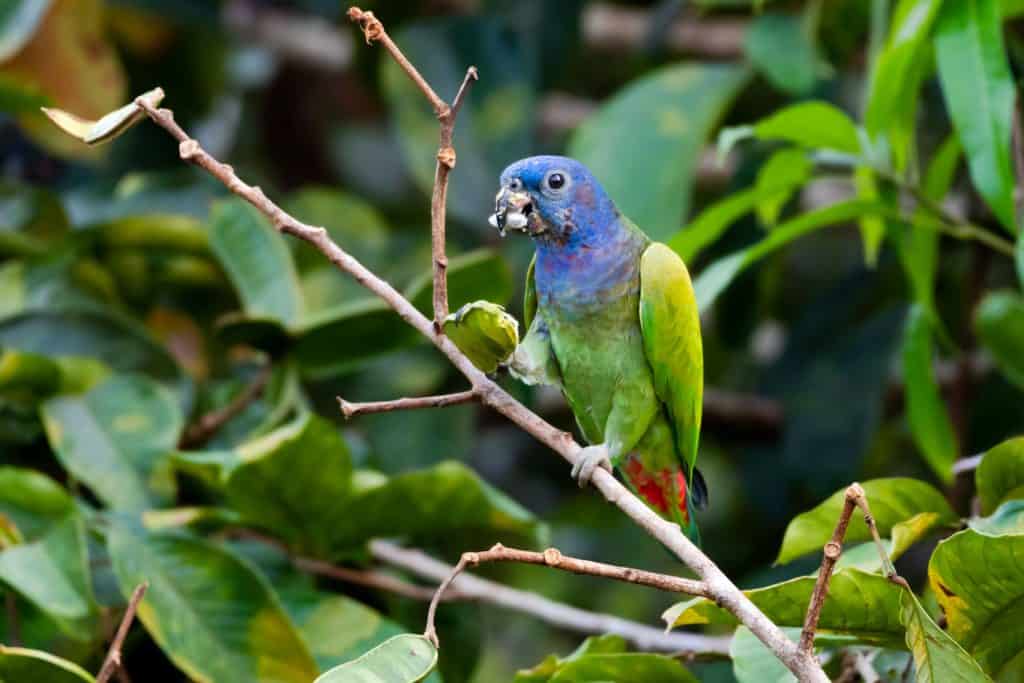If looking for a pet bird, the Pionus is a great addition. It is their great qualities that make owners attracted to them. This article provides a detailed guide on everything you need to know about the Pionus bird.
Johann Georg Wagler, a German naturalist, introduced the genus Pionus in 1832. Pionus are medium-sized parrots who are native to central and South America. Five out of the eight species in this genus are becoming common pet birds in households.
The Pionus Bird: All You Need to Know
Pionus Parrot Species
Pionus parrots have short square tails with stocky bodies. Their eyes are large and have a bare eye-ring. Pionus parrots are red-vented parrots because of the red coloring near their vents. It is the common factor that the parrot species has, as they seem to have different characteristics in all other avenues.
The Pionus family consists of eight species of birds. They include: blue-headed Pionus, Bronze-winged Pionus, coral billed Pionus, dusky Pionus, Maximilian Pionus, white-headed Pionus, plum-crowned Pionus, and white-capped Pionus.
The blue-headed Pionus has a dark gray bill and green body. It is among the most kept Pionus. It is considered the most beautiful looking in the Pionus family. Young ones have a mostly green body that feathers out into emerald green when they become adults.
The bronze-winged parrot has striking colors. You notice a dark bluish-green color on their upper neck, back of their head, and crown. Pink feathers are visible on their upper chest. While skin around the eye rings for younger parrots is whitish, on adults, it’s pink.
Coral-billed Pionus is also known as the red-billed Pionus. It is thanks to their unique bright red bill. In addition, they have a greenish plumage with a mixture of dull blue on their chest. They reside in humid and sub-tropical forests such as the coastal range of Venezuela.
You can compare the head of the dusky Pionus to the peregrine Falcon. It is because of the noticeable buff. These parrots are mostly dark brownish-gray. The 24cm long birds have tails and remedies that are blue. The belly has a pinkish-red color, and the upper-neck feathers are cream-white.
Maximillian Pionus are also known as scaly-headed Pionus. Many consider them to have less colorful plumage. One of their outstanding features is their scaly head with a white ring. Also, they have a purplish-blue chin. You can see the birds in small flocks or pairs (source).
Whitehead parrots have a dark green color on their upper part. They have a speckled appearance with a dullish green head and a white base. On the other hand, the white-capped Pionus is known for its white-feathered crown. It also has a bluish-green lower breast and a dark green upper breast.
Pionus Parrot Personality

Pionus parrots have become popular companion pets. These medium-sized birds are considered ideal and captivating birds.
Many regard these birds as slightly standoffish and quiet compared to other parrots. For example, these birds are pretty quiet compared to the Conure, Macaw, and Amazon. Also, they are a bit standoffish compared to the cockatoo family.
However, Pionus owners attest to their sweet, attentive, affectionate, and quieter (not wholly silent) nature. That said, aviculturists consider them less energetic and not very fond of hands-on play. For instance, they somewhat dislike being flipped on their backs, unlike our friends, the Caiques.
When weaning, the Pionus can be particularly stubborn. They become persistently loud, which goes on past the weaning period. It is often an expression of insecurity or hunger. Also, an observation by breeders is that chick Pionus are only ready to go to new homes after they are a few months old.
When in new surroundings, Pionus are at first tentative. As much as they adapt, it takes some time compared to other species. Once they adjust, they are more independent and have a low tendency to be demanding.
They can get very close to one person. So much so they become protective of them from other humans or family members. They generally don’t bite. It makes them great for families with kids. However, kids shouldn’t be allowed to pet parrots unsupervised, Pionus or otherwise.
Pionus make a wheezing sound when uncertain, upset, or stressed. For new owners, this may cause concern. However, this is typical of these birds and is not a sign of illness.
Hanging, playing, and climbing are part of the routine for these birds. Getting a cage that would be supportive of this is essential. You should also include toys to shun away boredom. They are particularly fond of puzzle toys.
Pionus Parrot Lifespan
Before purchasing any pet, you must take serious consideration. It particularly applies to those with a long lifespan. Pionus are known to live for about 25-40 years. It is not uncommon for Blue parrots to reach 40 years. This number drops to an average of 25 years because of accidents and poor nutrition.
Parrots, in general, are known to live between 40-80 years. It considers all species, meaning while others have a significantly lower lifespan, others have a higher one. Larger birds live longest, while smaller birds live for shorter periods.
The lifespan a bird has is affected by several factors. Non-food livestock or those in captivity have a longer lifespan than wild birds. Theri safety from predators, high-quality food, and a controlled environment to live in supports a longer lifespan.
However, Pionus in captivity faces the risk of shorter lifespans. Unhealthy environments can put them at risk. Also, detecting illnesses in birds can be difficult. Appearing healthy, even when they aren’t well, is their survival instinct.
Warning signs to look out for in parrots include feathers that stay fluffy and ruffled, appetite changes, changes in consistency and color of droppings, and trouble maintaining balance. Possible diseases include avian polyomavirus, chlamydiosis, and candidiasis.
You should provide Pionus parrots with a clean living environment. It will prevent the presence of yeast that causes candidiasis. Proper diets will also promote good health. You should consult with vets when preparing the perfect diet. It will also help to avoid harmful foods.
Parrots prefer seeds and are considered granivores. Their diet consists of pollen, nectar, buds, and seeds in the wild. They also consume animal prey such as arthropods.
Pionus Parrot Talking
One of the ways to bond with pet Pionus parrots is by teaching them how to speak. You can take several steps to ensure effective learning. It includes conducting the practice in a quiet room, regularly, and at the same time daily.
Every day, for about 10 minutes, guardians should look at the Pionus in the eye and talk to them about anything. It causes the parrot to familiarize itself with the guardian’s voice and how they communicate. It will make training them a smoother process.
Working with the birds in a quiet room is ideal as it prevents distractions from other elements and noises. The bird’s total focus is on the guardian. The area should be free of other pets or family members. You should also turn off cell phones, computers, and TVs.
Practicing at the exact time every day will prompt the bird to recall lessons learned in previous days. Time can either be in the mornings or evenings. This consistent practice will encourage faster learning.
People don’t consider Pionus the best talkers compared to other parrot species. However, other Pionus birds manage to build a large vocabulary. Their speaking voice may not be clear, but it’s easy to understand what they are saying.
The quiet nature of the birds makes them great apartment pets. Like other birds, however, a noisy environment makes the bird loud. It includes shouting children, blaring televisions, and barking dogs.
Is a Pionus Good for Beginners?

The common parrots for beginners are the cockatiels and the budgerigars. Many refer to Budgerigars or budgies as parakeets. These small birds are naturally yellow and green. They have been bred in captivity to achieve different coloring.
Budgies are popular because of their low cost, small size, and ability to talk. They are popular pets, third only to cats and dogs.
Cockatiels are also companion parrots, prized as home pets. They are native to Australia and are smaller members of the parrot species. People also refer to them as quarrions or weiro birds. Breeding these birds is easy, and they are popular caged birds. They are only second to budgies.
Pionus parrots are superb as apartment pets. They aren’t very needy; they are quiet and easy-going. Once they get used to their surroundings, they bond well with their owners. Their species is rare compared to budgies and cockatiels. Not many people own them, which makes them more charming.
Are Pionus Good Pets?
Pionus parrots are considered excellent pets. It is despite them being scarce in captivity. Of the eight existing species, only five are the commonly kept species. It includes Maximilian Pionus, Blue-headed Pionus, and the White-capped Pionus. Thanks to captive breeding, the Bronze-winged Pionus and the Dusky Pionus have become more common.
The most visually appealing of the Pionus family is the blue-headed Pionus. People opt for it due to its looks. While the Maximilian Pionus may be a bit duller, it is the largest at 12 inches.
Generally, Pionus are good eaters. It makes it necessary to feed them good diets. Nutritious diets also keep them from falling ill. In captivity, common health issues include Vitamin A deficiency, obesity, and aspergillosis.
Their primary diet should be formulated and combined with vegetables and fruits. It would be best to introduce a seed mix of high quality. These birds thrive on diets low in fat and protein. Therefore, they should be given commercially pelleted foods in smaller portions.
Given their passive nature, you should watch Pionus parrots’ calories. Their good appetites make them readily receptive to new diets and varied diets.
Research shows it’s advantageous to buy captive-bred youngsters, whether they are purchased for future breeding or as pets. This way, owners are assured of healthy birds that haven’t undergone the trauma of being trapped and shipped over long distances.
It also means that the birds’ behaviors will directly reflect the people who bred them.
Pionus don’t have a significant sexual dimorphism. Various methods of sexing, therefore, are used. It includes chromosomal analysis, surgical sexing, and DNA sexing. Once a female and male are available, breeding them is easy.
Since the introduction of DNA sexing, it has become more popular. Its inexpensive and non-intrusive nature has appealed to many. Surgical sexing is preferred by others because it helps identify abnormalities, while chromosome analysis identifies genetic conditions.
I recommend that you choose hens as pets in situations where more than two people will do handling. It is because of their docile nature compared to males (in maturity). While hens can live in pairs, males have a hard time doing so. Males become aggressive towards one another.
Another factor to consider for maintaining these birds is covering their cages at night. It is because it keeps them warm, and it prevents night frights. Also, it would be best to consider males when searching for a talking bird. It is because they are better talkers compared to females.
How Much does a Pionus Parrot Cost?
Purchasing birds requires time and consideration. Doing this on a whim can be detrimental to both the owner and the bird. Therefore, you should conduct prior planning and budgeting.
Generally, one can own a Pionus parrot for $200 to $900. The price of these birds ranges between that price. Deciding how much one wants to spend before getting the animal will prevent any impulse purchases due to attachments.
Bronze-winged Pionus tend to be more expensive, costing as high as $900 thanks to their rarity. If funds are limited, one should opt for the White-capped Pionus that costs about $200 to $400. It is because of their availability in the market.
How Big Should a Cage be For a Pionus Bird?
Cages that work for Amazon parrots should work well for the Pionus parrots. The enclosures provided should be spacious enough to encourage movement. It includes daily exercises and wing stretching.
The suggested floor space for a single bird should be about 30×30 inches. The length should then be about 32 inches.
Summary
Pionus parrots are an excellent addition to the family. It is encouraged by both their size and their temperaments. Apartment owners will find them to be quite appealing. Also, with fewer people owning them, it makes them more unique.
The lifespan of the Pionus parrot minimizes losses associated with pet death. It creates a long-term bond with them. Provided these birds are properly fed and taken care of, they become a fan favorite of the entire family.
-
What Size Cage Is Needed For A Conure Parrot?
What size cage is needed for a conure parrot? Conures can be highly active and playful, so they need a dedicated space for flying and exploring. There should also be room for toys as they help keep conures occupied. A conure’s enclosure should be at least 18 to 24 square inches, depending on its size.
-
Can Parakeets Eat Blueberries?
There’s no denying that parakeets are curious about everything. They are quickly intrigued and fascinated with anything new, especially regarding things they can consume or not. It’s in their nature to be curious about their surroundings. Besides, their wonder and curiosity took them into our hearts in the first place. Indeed, sometimes you get a
-
The Costs Of Owning A Sun Conure Parrot
Sun conures (Aratinga solstitialis) are parrot birds known for their beauty and intelligence. Jandaya parakeets (Aratinga jandaya) and Golden-capped parakeets (Aratinga auricapillus) are taxonomically included in the group. They are bright-orange plumage on the forehead and abdomen. (source) These birds originated in northern and central-eastern South America. Naturally, they inhabited dry areas, settled in either
-
A Complete Guide To Parakeet Sexing
You have finally adopted a parakeet and love spending time with your new pet as it’s making everyone in your home happy. But since it’s still a new pet, you’re still trying to figure out a perfect name for your bird. Unfortunately, you don’t know its gender since you got it as a gift or
-
A Guide To Clicker Training For Birds
Finally, you can introduce clicker training for birds by asking them to continue doing what they love! It can be something as simple as a step up, a handshake, or a high-five. With your reward nearby and a clicker in your hand, you can verbally command your birds. And when your bird does it correctly,
-
Macaw Blue and Gold Price (Plus 7 Things To Know)
Known for its stunning form and beautiful colors, the Blue and Gold Macaw truly is a glorious bird to look at, and it is no question to know that this bird also comes with a hefty price. Aside from its striking colors, it also is brilliant and, most significantly, high in demand. With such a
- Wikipedia, https://en.wikipedia.org/wiki/Pionus, Accessed 12th February 2022
- Suzanne Henley Myers, American Federation of Aviculture, https://journals.tdl.org/watchbird/index.php/watchbird/article/view/858, Accessed 12th February 2022
- Wikipedia, https://en.wikipedia.org/wiki/Bronze-winged_parrot, Accessed 12th February 2022
- Wikipedia, https://en.wikipedia.org/wiki/Red-billed_parrot#:~:text=The%20red%2Dbilled%20parrot%20(Pionus,parrot%20in%20the%20family%20Psittacidae., Accessed 12th February 2022
- Wikipedia, https://en.wikipedia.org/wiki/Dusky_parrot, Accessed 12th February 2022
- Wikipedia, https://en.wikipedia.org/wiki/Scaly-headed_parrot, Accessed 12th February 2022
- Lafeber Company, https://lafeber.com/pet-birds/species/pionus-parrots/, Accessed 12th February 2022
- Wikipedia, https://en.wikipedia.org/wiki/Pionus#Pets, Accessed 12th February 2022
- Suzanne Henley Myers, American Federation of Aviculture, https://journals.tdl.org/watchbird/index.php/watchbird/article/view/858, Accessed 13th February 2022
- Margrethe Warden, American Federation of Aviculture, https://journals.tdl.org/watchbird/index.php/watchbird/article/view/3108, Accessed 13th February 2022
- UWI, https://sta.uwi.edu/fst/lifesciences/sites/default/files/lifesciences/documents/ogatt/Pionus_menstruus%20-%20Blue-headed%20Parrot.pdf, Accessed 13th February 2022
- Kyle Glatz, A-Z Animals, https://a-z-animals.com/blog/discover-the-worlds-oldest-parrot/, Accessed 13th February 2022
- Web MD, https://pets.webmd.com/how-long-do-parrots-live, Accessed 13th February 2022
- Pippa Elliot, Wiki How, https://www.wikihow.com/Teach-a-Pionus-Parrot-to-Speak
- Lafeber Company, https://lafeber.com/pet-birds/species/pionus-parrots/, Accessed 13th February 2022
- Wikipedia, https://en.wikipedia.org/wiki/Budgerigar, Accessed 13th February 2022
- Wikipedia, https://en.wikipedia.org/wiki/Cockatiel, Accessed 13th February 2022
- Wikipedia, https://en.wikipedia.org/wiki/Pionus#Pets Accessed 14th February 2022
- Margrethe Warden, American Federation of Aviculture, https://journals.tdl.org/watchbird/index.php/watchbird/article/view/3108, Accessed 14th February 2022
- Jennie Bolton, https://theparrotsocietyuk.org/site/index.php/parrot-information/articles/articles-on-parrot-species/pionus-parrots/, Accessed 14th February 2022
- Suzanne Henley Myers, American Federation of Aviculture, https://journals.tdl.org/watchbird/index.php/watchbird/article/view/1402, Accessed 14th February 2022
- Pippa Elliot, Wiki How, https://www.wikihow.pet/Choose-a-Pionus-Parrot, Accessed 14th February 2022
- Pippa Elliot, Wiki How, https://www.wikihow.com/Set-Up-a-Pionus-Parrot-Habitat Accessed 14th February 2022




